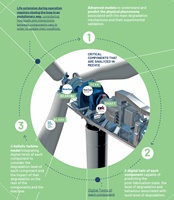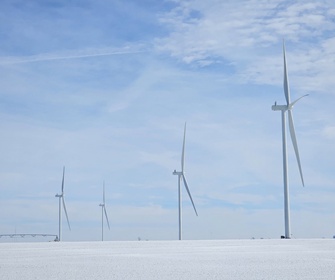 The MEEVCE project, entitled “Evolutionary method to extend the life of wind turbine components”, has spent two years conducting research into creating the knowledge necessary to obtain an evolutionary methodology for extending the useful life of wind components under real operating conditions.
The MEEVCE project, entitled “Evolutionary method to extend the life of wind turbine components”, has spent two years conducting research into creating the knowledge necessary to obtain an evolutionary methodology for extending the useful life of wind components under real operating conditions.The consortium is coordinated by Ikerlan and also includes Bearinn, Ceit Mondragon University, and the Basque Energy Cluster. The results were presented at a transfer workshop organised by the Basque Energy Cluster on February 26th at Ikerlan's facilities.
The partners showcased the holistic model they developed, for which they designed an open source health-conscious wind turbine simulation model. This model, which was developed in openFAST, was used to implement different faults and health states in order to evaluate the power generation and loads under different wind turbine health scenarios.
Mondragon University has developed stochastic models to estimate the evolution and spread of surface degradation of wind turbine blades. In this way, they were able to assess the impact of the effects of blade surface degradation on the performance of wind turbines. They also had the opportunity to evaluate new materials/prototyping technologies to test the effects of aerodynamic blade surface degradation in wind tunnels.
Meanwhile, Ikerlan worked on developing a digital twin for the pitch gear with the aim of predicting the evolution of the integrity of the pitch gear against wear under realistic wind loads acting on the wind turbine blade. By applying it to NREL 5MW, they were able to obtain wear profiles for two different scenarios: pristine blade and progressively degraded blade.
Bearinn was responsible for developing a new method to assess the impact of the structural factor on the degree of wear over the bearing's entire life. They also developed an evolutionary method to assess the theoretical impact of blade wear on the bearing tooth itself. To this end, they analysed the impact of test rigidity on component degradation using FE models and sensorised rolling elements and inductive sensors to detect track degradation during component testing.
Lastly, Ceit focused on developing an evolutionary model of the microstructure after quenching and tempering Q&T steels for large parts. They also analysed the effect of overloading on the delay/acceleration of crack growth on the main shaft of the wind turbine by implementing it in FE simulations.
The MEEVCE project is funded by the Basque Government's Department for Economic Development, Sustainability and the Environment.








